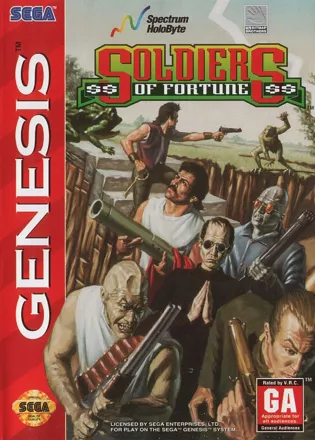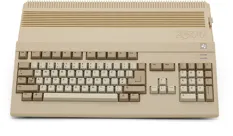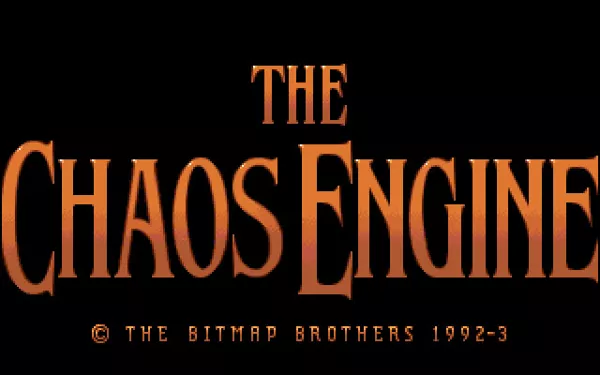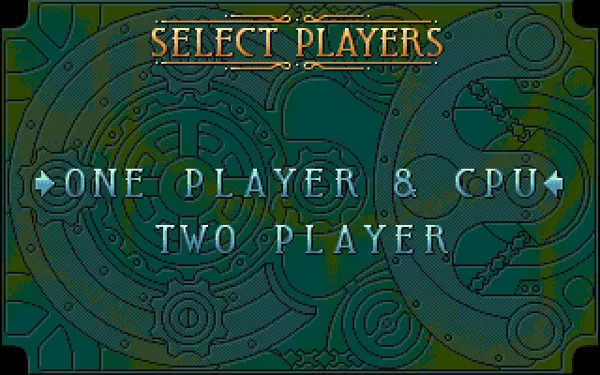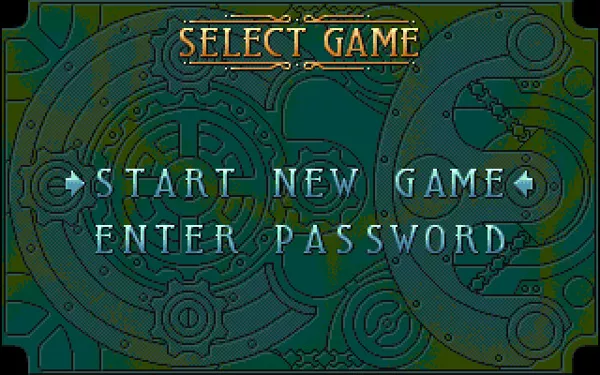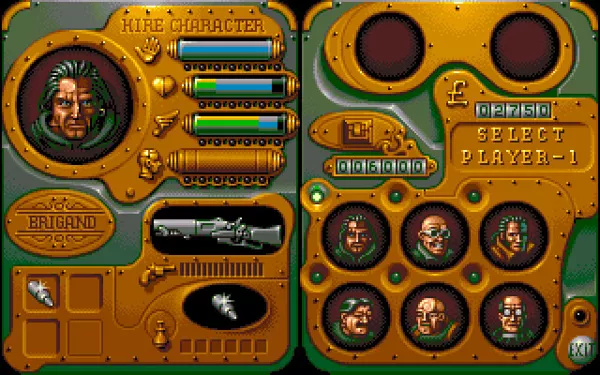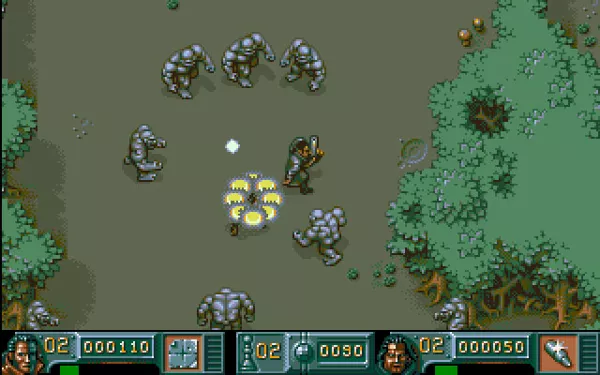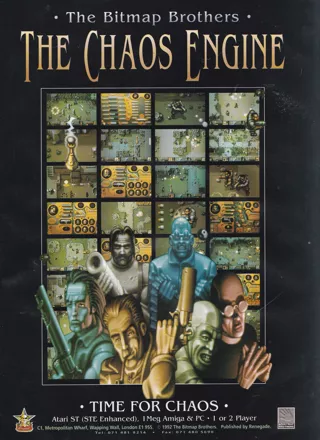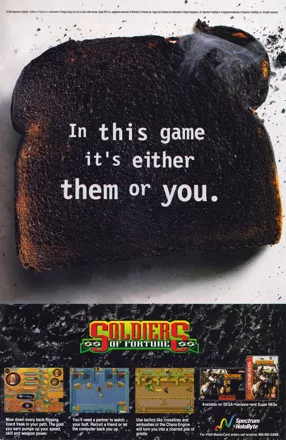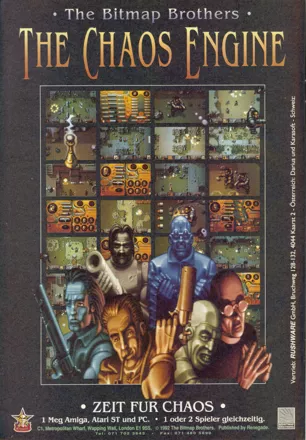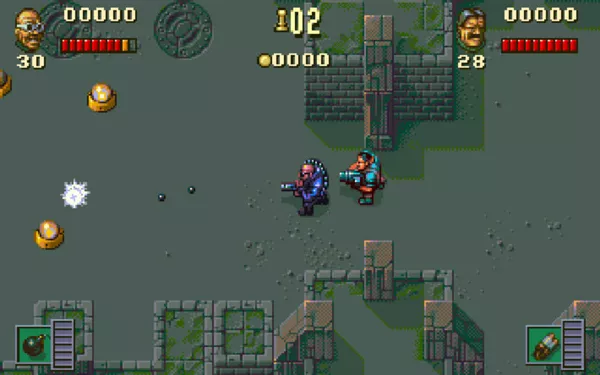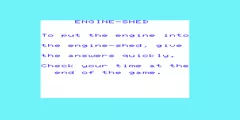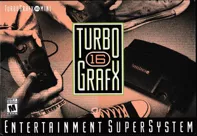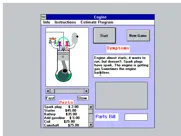Soldiers of Fortune
Description official descriptions
A time traveler from the future was stranded in Victorian England, and his knowledge of yet unknown technological inventions was passed to the Royal Society, headed by Baron Fortesque. With the help of this knowledge, Fortesque managed to construct an immensely complex artificial intelligence known as the Chaos Engine. However, creation rebelled against its creator, assimilated its mind, and turned Britain into a war zone populated by mad machines. Mercenaries are willing to enter this dangerous place and put an end to the chaos, hoping for an appropriate reward.
Chaos Engine (Soldiers of Fortune in the US) is a run-and-gun overhead shooter. Sixteen levels (in four groups of four) await the players in the game. The basic gameplay is similar to Gauntlet, but in an open-air setting, with bridges across rivers and other features in the maps. The visuals are in the 'metallic and blue' style Bitmap Brothers appeared to favor.
There are six characters available in the game, each with different strengths and weaknesses, and different starting prices. In two-player mode, each player chooses a character and plays co-operatively, but in one-player games, the player also chooses a character for the computer to control, with its artificial intelligence allowing it to open doors, pick up power-ups and take on enemies away from the ones occupying the player-controlled character.
Groups +
Screenshots
Promos
Videos
Add Trailer or Gameplay Video +1 point
See any errors or missing info for this game?
You can submit a correction, contribute trivia, add to a game group, add a related site or alternate title.
Credits (Genesis version)
28 People (19 developers, 9 thanks) · View all
| Design | |
| Graphic Design | |
| Graphic Conversion | |
| Original Code | |
| Code Conversion | |
| Additional Code | |
| Original Game Music | |
| SFX | |
| Sound Conversion |
|
| Title Music | |
| Project Management | |
| Special Thanks | |
| Product Manager | |
| Testing | |
| Instruction Manual | |
| Marketing | |
| Special Thanks | |
| [ full credits ] | |
Reviews
Critics
Average score: 78% (based on 58 ratings)
Players
Average score: 3.7 out of 5 (based on 88 ratings with 7 reviews)
Bitmap Brothers - the recyclers
The Good
everything
The Bad
can't see anything except Bitmap Brothers being hibernating or something.
The Bottom Line
Bitmap brothers definitely are, or were, I don't know, one of the first teams that deposited real passion, art, and the concept of recycling making homage to (as Tarantino does in movies), on videogames. They were definitely mature indie game constructors, and they presented that on fluidity marrying graphics in an organic playable sense. The Chaos Engine is another game that demonstrates that. An inspirational classic game with direct passport to the hall of fame of Artistic games.
Windows · by ZeTomes (36193) · 2014
The Good
The Bitmap Brothers, a well-known game company based in the UK, produced good quality action games like Xenon 2: Megablast, Magic Pockets, Cadaver: The Payoff, and Gods, as well as this game, The Chaos Engine.
The story is self-explanatory enough. An experimenter with time space and early computers made a huge mistake of creating a bizarre machine, which he called “The Chaos Engine”. Soon the machine became very powerful and turned against its creator, causing a cloud of chaos to descend over the land and turning all humans and animals into beasts. And now The Chaos Engine must be destroyed in order to restore peace and beauty to the land.
Six mercenaries are offered the job: Mercenary, Brigand, Gentleman, Navvie, Thug, and Preacher. Each mercenary has their own advantages and disadvantages, and their own firepower. When players start the game, they have the choice of playing against the CPU or another player.
Once done, each player choose their mercenary. Whether that mercenary is good or not will depend on how much speed, wisdom, skill, health, and firepower they have got. Also each character has their own special attacks. For example, Gentleman can use maps to navigate his way through each level, while Navvie uses dynamite to blast enemies in a direction he is facing.
Once done, the game begins. Each player has low firepower and less speed, wisdom, health, and skill at the start, but can upgrade these after every second level, or obtain an extra life (with the maximum of 30). There are four worlds to complete with each world consisting of four levels, and each world has players navigating through forests, workshops, mansions, sewers, and cellars, and blasting beasts in the process. A password is given at the end of each world, which players can input that allows them to start at the beginning of a world.
The main objective of the game is to find and activate several nodes that are scattered through each level, and collect gold and silver keys that will cause bridges, a set of stairs, or secret passages to appear so that you can explore other parts of the level. The number of nodes you have to activate is listed in the middle of the status bar. Once all the nodes have been activated, the level exit is opened. In several levels, there is more than one exit, and players will end up at a different place in the next level, depending on the path they take through the level.
Normally, when players kill an enemy, the enemy will leave behind gold or silver coins, which can be used to upgrade both mercenaries. The number of coins that each player collects is displayed next to the number of nodes. Also there are more items that players can collect rather than just coins. If players collect a yin-yang at a point in the level, for example, they restart at that point if they die. There’s also food to collect that will award extra health, power-ups that will upgrade firepower, special attacks, and of course, extra lives. When a level is complete, a screen of statistics comes up telling how many enemies they’ve destroyed, the number of nodes activated, how many coins the party collected, how many gold and silver keys that were collected, and so on.
The graphics are great, and the sound effects in this game are awesome. The music in the Amiga version is much better than the DOS version. I like the fact that the music changes whenever you explore different areas of a level, because this way you don’t get sick and tired of hearing the same music over and over again.
The Bad
This game can be difficult if neither of the mercenaries that were selected have the right firepower to take enemies down, especially the final boss. It isn’t easy to beat him, and may take you several hours to figure out how to beat him. It took me two days to find a tactic on how to beat him, and stick to it.
The Bottom Line
Overall, great game with excellent sound and graphics. If you finished this game already, it may not be over for you. There are other characters to choose from, and different firepower to equip them with. Also this game has different paths and alternative exits that you could take. Followed by a sequel. ***½
Amiga · by Katakis | カタキス (43085) · 2002
Pumping with action and keeps you amused for ages.
The Good
This game was one of the best Bitmap games, a well thought out storyline for an Action game. Play with the computer or with a friend and you are set on blasting baddies and collecting as many extra powers as you can. Once you have completed the game, the task becomes one on using different characters and finding the maximum amount of treasure for each level.
The Bad
First played this game on the Amiga where the music is far better than that of the DOS version that seems to have been rewritten, the RISC OS version has been converted better. It appears the music is the only bad tiding as the rest of the game is brilliant. It's age is showing in that the graphics are only 16 colours but they are done in a Amiga-esque way to hide that.
The Bottom Line
If you like an action game with a bit more brain-power to put behind and like collecting various tokens and listening to cool effects then this is the game for you. Now starting to show what real games were like moons ago.
DOS · by Nathan Walker (4) · 2000
Discussion
| Subject | By | Date |
|---|---|---|
| Level Editor released + first custom level | lilalurl (733) | Jun 26, 2010 |
Trivia
Advertisement
Shortly after the game's release, Renegade took out a full page advert in trade magazine CTW, which simply said "The Chaos Engine. So good, even that bastard Stuart Campbell liked it", referring to a British journalist who had a habit of not liking much-hyped games, including previous Bitmap Brothers titles Xenon 2: Megablast and Gods, but gave this one a great review. Ironically Campbell later worked for CTW (as of 2004).
Development
The original beta version (as seen on TV in many countries) was a three player game (not two).
German index
On 31 March 1995, The Chaos Engine was put on the infamous German index by the BPjS. For more information about what this means and to see a list of games sharing the same fate, take a look here: BPjS / BPjM indexed games.
Passwords
A quote from the manual addendum lying in the game box:
Please note - In order to continue the time-honoured Bitmap Brothers tradition of mucking around with the password system at the last minute, The Chaos Engine now only awards passwords at the end of every world rather than after every Equipment Screen.
Sorry.
Version differences
- In both the SNES and Genesis versions of the game which are named Soldiers of Fortune, the game's ending credits still call it The Chaos Engine.
- In the console versions the Preacher was changed into a Scientist due to Sega and Nintendo having a policy of censoring any religious material in games for their consoles.
Awards
- Amiga Joker
- Issue 02/1994 – #2 Best Genre Mix in 1993 (Readers' Vote)
- Power Play
- Issue 02/1994 – Best Multiplayer Game in 1993
Information also contributed by Johnny "ThunderPeel2001" Walker, Martin Smith, Timo Takalo, WildKard and Xoleras
Analytics
Related Sites +
-
www.gods-country.de
The Bitmap Brothers tribute page for this game
Identifiers +
Contribute
Are you familiar with this game? Help document and preserve this entry in video game history! If your contribution is approved, you will earn points and be credited as a contributor.
Contributors to this Entry
Game added by Derrick 'Knight' Steele.
Atari ST, Genesis added by kametyken. Antstream added by firefang9212. Linux, Amiga CD32, Acorn 32-bit, J2ME, Macintosh, Windows added by Kabushi. BlackBerry added by MAT. SNES added by Katakis | カタキス. Amiga added by Rantanplan.
Additional contributors: Macintrash, -Chris, kametyken, Martin Smith, Patrick Bregger, Plok.
Game added February 29, 2000. Last modified March 11, 2025.


